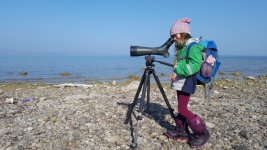Agreed, and in addition straight scope often:
-many times offer better optics because angled scopes require extra prisms and coatings that can have an effect on letting slightly less light reaching the eyepiece
- slightly better in foul weather without rain, snow, etc. landing on eyepiece
- better body posture for some of those with bad back pain
- easier to look downward if you are on top of canyon, cliff, or bay
I totally agree about body posture.
I don't like bending down, especially if there's someone behind me 3

More seriously, I don't personnaly find it confortable.
I bought a straight scope to go to the Mountains, for the reason mentionned by 61999 above, that it is easier to look down, from a high point.
Another benefit of a straight scope, is like almost everyone buy an angled scope, the straight ones are difficult to be sold, so you can find them with a generous rebate from retailers.
Like someone else said earlier, a negative side of straight scopes, is when your partner is with you, and that you're sharing the scope and that you have to adjust the height of the central column of your tripod.
We did find a solution to that, my girlfriend is now taking a foldable plastic thingie made for gardening with her to climb on, whenever she wants to look through the scope.
And I agree, there's an optical difference between the straight scope and the angled (seen on Kowa's scopes).
Another good thing, but this is more about my use while hiking, is sometimes, I want to look at what something is, and without having to set up the tripod and all (in the case my 15x binos don't help).
I bought a cheap plastic handle made for video with DSLR.
I just get my scope, lock the handle and I can have a quick look at something, without having to spend 5minutes setting up my tripod.







